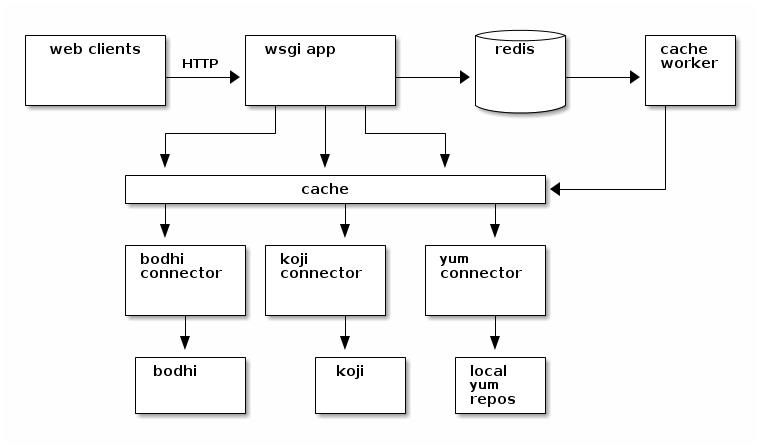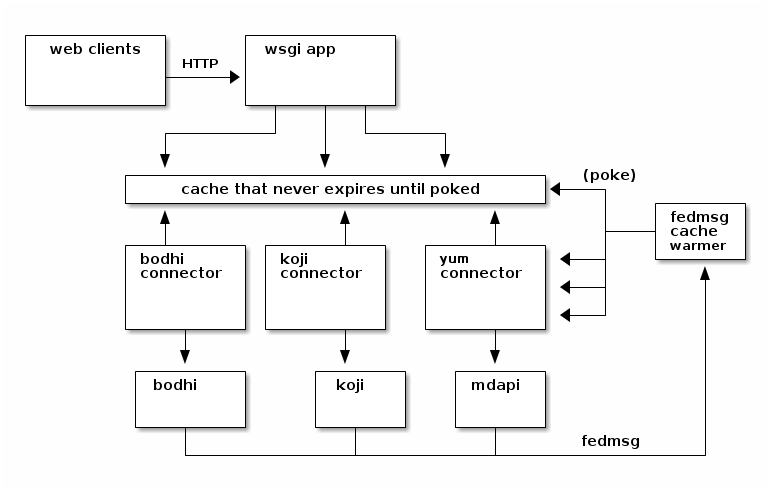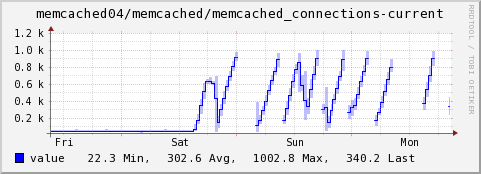[three]Bean
Backend rewrite of the Fedora-Packages webapp
Nov 20, 2015 | categories: python, cache, fedora View CommentsJust yesterday, we deployed the 3.0 version -- a rewrite -- of the fedora-packages webapp (source). For years now, it has suffered from data corruption problems that stemmed from multiple processes all fighting over resources stored on a gluster share between the app nodes. Gluster's not to blame. It's that too many things were trying to be "helpful" and no amount of locking would seem to solve the problem.
tl;dr
We have lots of old, open tickets about various kinds of data being missing from the webapp. Those are hopefully all resolved now. Please use it and file new tickets if you notice bugs. Patience appreciated.
Architecture
Let's take a look at the internal architecture of the app. It's a cool idea. It doesn't really have any data of its own, but it is a layer on top of our other packaging apps; it just re-presents all of their data in one place. This is the "microservices" dream?
Here we have a diagram of the system as it was originally written in its "2.0" state.

HTTP requests come in to the app either for some initial page load or for some kind of subsequent ajax data. The app hands control off to one of two major subsystems -- a "widgets" controller that handles rendering all the tabs, and a "connectors" dispatcher that handles gathering and returning data. The widgets themselves actually re-use the connectors under the hood to prepare their initial data.
More complicated than that
First, there are only three widgets/connectors depicted above, but really there are many more (a search connector, a bugzilla connector, etc..). Some of them were written, but never included any place in the app (in the latest pass through the code, I found an unused TorrentConnector which returned data about Fedora torrent downloads!).
Note that over the last few years, the widgets subsystem has remained largely unchanged. It is a source of technical debt, but it hasn't been the cause of any major breakages, so we haven't had cause to touch it. The widgets have metaclasses under the hood, can be nested into a hierarchy, and can declare js/css resource dependencies in a tree. It's pretty massive -- all on the server-side.
There is also (not depicted) an impenetrable thicket of javascript that gets served to clients which in turn wires up a lot of the client-side behavior.
Lastly, there are (were) a variety of cronjobs (not depicted) which would update local data for a subset of the connectors. Notably, there was a yum-sync cronjob that would pull the latest yum repodata down to disk. There was a cronjob that would pull down all the latest koji builds "since the last time it ran". Another would crawl through the local yum repos and rebuild the search index based on what it thought was in rawhide.
Just... keep all that in mind.
Focus on the connectors
Here's a simpler drawing:

So, when it was first released, this beast was too slow. The koji connector would take forever to return.. and bugzilla even longer.
To try and make things snappy, I added a cache layer internally, like this:

The "connector middleware" and the widget subsystem would both use the cache, and things became somewhat more nice! However, the cache expiry was too long, and people complained (rightly) that the data was often out of date. So, we reduced it and had the cache expire every 5 minutes. But.. that defeated the whole point. Every time you requested a page, you were almost certainly guaranteed that the cache would already be expired and you'd have to wait and wait for the connectors to do their heavy-lifting anyways.
Async Refresh
That's when (back in 2013), I got this idea to introduce an asynchronous cache worker, that looked something like this.

If you requested a page and the cache data was too old, the web app would just return the old data to you anyways, but it would also stick a note in a redis queue telling a cache worker daemon that it should rebuild that cache value for the next request.
I thought it was pretty cool. You could request the page and sometimes get old data, but if you refreshed shortly after that you'd have the new stuff. Pages that were "hot" (being clicked on by multiple people) appeared to be kept fresh more regularly.
However, a page that was "cold" -- something that someone would visit once every few months -- would often present horribly old information to the requester. People frequently complained that the app was just out of sync entirely.
To make matters worse, it was out of sync entirely! We had a separate set of issues with the cron jobs (the one that would update the list of koji builds and the one that would update the yum cache). Sometimes, the webapp, the cache worker, and the cronjob would all try to modify the same files at the same time and horribly corrupt things. The cronjob would crash, and it would never go back to find the old builds that it failed to ingest. It was a mess.
The latest rewrite
Two really good decisions were made in the latest rewrite:
First, we dispensed entirely with the local yum repos (which were the resources most prone to corruption). We moved that out to an external network service called mdapi which is very cool in its own right, but it makes the data story much more simple for the fedora-packages app.
Second, I replaced the reactive async cache worker with an active event-driven cache worker. Instead of updating the cache when a user requests the page, we update the cache when the resources change in the system we would query. For example, when someone does a new build in the buildsystem, the buildsystem publishes a message to our message bus. The cache worker receives that event -- it first deletes the old JSON data for the builds page for that package in the cache, and then it calls the KojiConnector with the appropriate arguments to re-fill that cache value with the latest data.
We turned off expiration in the cache all-together so that values never expire on their own. The outcome here is that the page data should be freshly cached before anyone requests it -- active cache invalidation.

With those two changes, we were able to kill off all of the cronjobs.
Some additional complications: first, the cache worker also updates a local xapian database in response to events (in addition to the expiration-less cache), but it is the only process doing so and so can hopefully avoid further corruption issues.
Second, the bugzilla connector can't work like this yet because we don't yet have bugzilla events on our message bus. Zod-willing, we'll have them in January 2016 and we can flip that part on. The bugs tab will be slower than we like until then. UPDATE: We got bugzilla on the bus at the end of March, 2016.
Looking forwards
We're building the fedora-hubs backend with the same kind of architecture (actively-invalidated cache of tough-to-assemble page data), so, we get to learn practical lessons here about what works and what doesn't.
Do hit us up in #fedora-apps on freenode if you want to help out, chat, or lurk. I'll be cleaning up any loose bugs on this deployment in the coming weeks while starting work on a new pdc-updater project.
Async Caching & the Fedora Packages App
Feb 07, 2013 | categories: python, cache, ruby, fedora View CommentsBackstory
Luke (lmacken) Macken, John (J5) Palmieri, and Máirín (mizmo/miami) Duffy created the Fedora Packages webapp; its initial release was about this time last year at FUDCon Blacksburg. It is cool!
Over the summer, I wrote a python api and cli tool called pkgwat to query it. David Davis then wrote his own ruby bindings which now power the Is It Fedora Ruby? webapp.
In late 2012 as part of another scheme, I redirected the popular https://bugz.fedoraproject.org/$SOME_PACKAGE alias from an older app to the packages app's bug list interface.
There was a problem though: developers reported that the page didn't work and was too slow!
Darn.
Caching
There were a number of small bugs (including an ssl timeout when querying Red Hat's bugzilla instance). Once those were cleared there remained the latency issue. For packages like the kernel, our shiny webapp absolutely crawled; it would sometimes take a minute and a half for the AJAX requests to complete. We were confused -- caching had been written into the app from day one, so.. what gives?
To my surprise, I found that our app servers were being blocked from talking to our memcached servers by iptables (I'm not sure how we missed that one). Having flipped that bit, there was somewhat of an improvement, but.. we could do better.
Caching with dogpile.cache
I had read Mike Bayer's post on dogpile.cache back in Spring 2012. We had been using Beaker, so I decided to try it out. It worked! It was cool...
...and I was completely mistaken about what it did. Here is what it actually does:
- When a request for a cache item comes in and that item doesn't exist, it blocks while generating that value.
- If a second request for the same item comes in before the value has finished generating, the second request blocks and simply waits for the first request's value.
- Once the value is finished generating, it is stuffed in the cache and both the first and second threads/procs return the value "simultaneously".
- Subsequent requests for the item happily return the cached value.
- Once the expiration passes, the value remains in the cache but is now considered "stale".
- The next request will behaves the same as the very first: it will block while regenerating the value for the cache.
- Other requests that come in while the cache is being refreshed now do not block, but happily return the stale value. This is awesome. When a value becomes stale, only one thread/proc is elected to refresh the cache, all others return snappily (happily).
The above is what dogpile.cache actually does (to the best of my story-telling abilities).
In my imagination, I thought that step number vi didn't actually block. I thought that dogpile.cache would spin off a background thread to refresh the cache asynchronously and that number vi's request would return immediately. This would mean that once cache entries had been filled, the app would feel quick and responsive forever!
It did not work that way, so I submitted a patch. Now it does. :)
Threads
A programmer had a problem. He thought to himself, "I know, I'll solve it with threads!". has Now problems. two he
With dogpile.cache now behaving magically and the Fedora Packages webapp patched to take advantage of it, I deployed a new release to staging the day before FUDCon and then again to production at FUDCon on Saturday, January 19th, 2013. At this point our memcached servers promptly lost their minds.

Mike Bayer sagely warned that the approach was creepy.
Each of those threads weren't cleaning up their memcached connections properly and enough were being created that the number of concurrent connections was bringing down the cache daemon. To make it all worse, enough changes were made rapidly enough at FUDCon that isolating what caused this took some time. Other environment-wide FUDCon changes to my fedmsg system were also causing unrelated issues and I spent the following week putting out all kinds of fires in all kinds of contexts in what seemed like a never-ending rush. (New ones were started in the process too, like unearthing a PyCurl issue in python-fedora, porting the underlying mechanism to python-requests, only to encounter bundling, compatibility, and security bugs there.)
A long-running queue
During that rush, I reimplemented my async_creator.
Where before it would start up a new thread, do the work, update the cache, and release the mutex, now it would simply drop a note in a redis queue with python-retask. With that came a corresponding worker daemon that picks those tasks off the queue one at a time, does the work, refreshes the cache and releases the distributed dogpile lock before moving on to the next item.
The app seems to be working well now. Any issues? Please file them if so. I am going to take a nap.